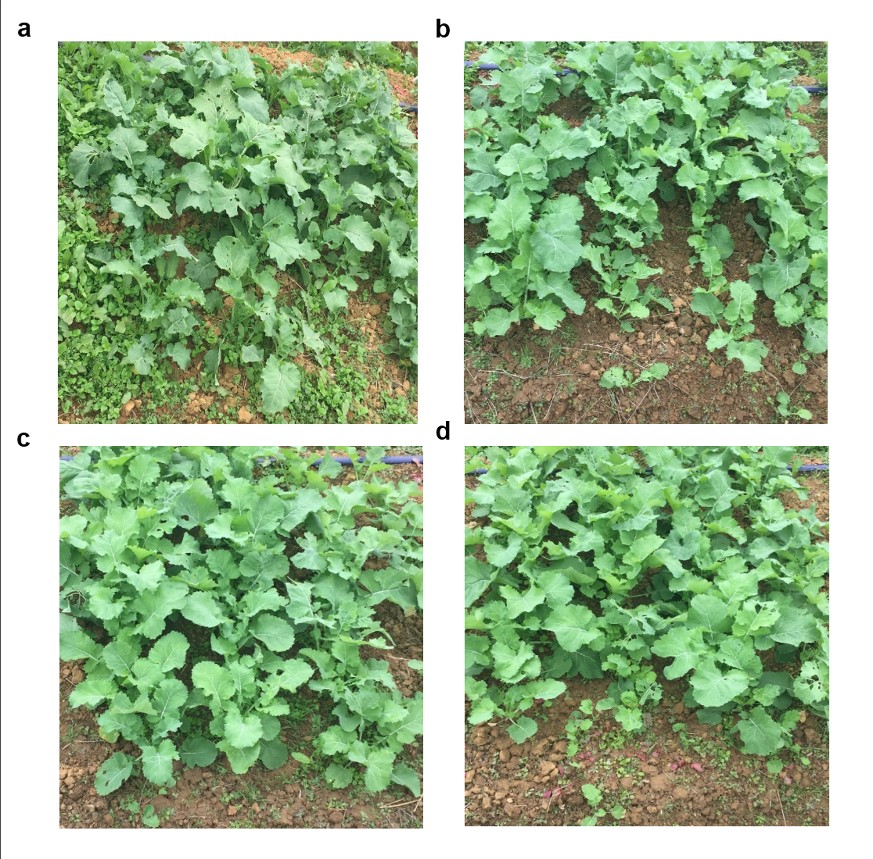Rapeseed is the largest oilseed crop in China, and its stable production plays a vital role in guaranteeing the national grain and oil safety. Weed management has always been a problem for rapeseed production. In recent years, the rapeseed research team, headed by Prof. Maolong Hu, of the Institute of Industrial Crops at Jiangsu Academy of Agricultural Sciences (JAAS) have been committed to the development and application of non-transgenic herbicide-resistant germplasm. They have made significant progress and been recognized as the international leader in this research area, and their research achievements have also been warmly welcomed by the market.
Weeds is the main biological disaster of rapeseed production, and it is also one of the important factors restricting rapeseed mechanization and simplified cultivation. Herbicides have become essential tools in modern agriculture for efficient weed control in the field, but the area of field applying chemical control of weeds in China is very limited, mainly due to the lack of herbicide-resistant rapeseed cultivars. Sulfonylurea (SU) herbicides have the advantages of low application rates, broad spectrums of weed control, soil residual activity, high margins of crop safety, and low mammalian toxicity, which are the most widely used herbicides. However, due to the lack of practical SU herbicide-resistant rapeseed germplasm or genes, so far there is no successfully commercialized SU-resistant rapeseed cultivars in China.
In order to develop new rapeseed germplasm with high SU herbicide-resistance, Prof. Maolong Hu’s research team performed molecular pyramiding technology to create the non-transgenic germplasm 5N with high-resistance to SU herbicide.They developed two rapeseed lines (PN19 and M342) with sulfonylurea herbicide resistance through seed mutagenesis. Molecular analysis revealed a Trp-574-Leu mutation in BnAHAS1-2R of PN19 and BnAHAS3R of M342 according to the sequence of Arabidopsis thaliana, respectively, and two allele-specific cleaved amplified polymorphic sequence marker were developed to target the point mutation. Second, the double mutant (5N) with very high sulfonylurea resistance was then developed through pyramiding two mutant genes of PN19 and M342 by molecular marker-assisted selection. Herbicide resistance identification, toxicology testing, and an in vitro enzyme activity assay of AHAS in 5N indicated that each mutant was four and eight times more resistant to sulfonylurea than M342 and PN19, respectively. 5N plants from resistance lines showed complete resistance, presenting no symptoms of chlorosis or necrosis after 3 weeks of treatment, even at much higher rates of application of both herbicides (360 gai ha–1 TBM and 180 gai ha–1 MES). Protein structure analysis of AHAS1 demonstrated that the leucine of mutant Trp-574-Leu destroyed the original π-plane stacking effect of the local region for tribenuron-methyl binding, leading to herbicide tolerance. Isobole graph analysis showed a significant synergistic effect of the combination of two mutant genes in 5N for improved tolerance to sulfonylurea herbicides. They also bred China’s first non-transgenic rapeseed cultivar Ning R101 and later Ning R201 by utilizing the resistance of 5N, weed control effect of which is significant in the field. Relevant research results were published in the well-known international agronomy journal Theoretical and Applied Genetics with the title "Synergistic mutations of two rapeseed AHAS genes confer high resistance to sulfonylurea herbicides for weed control" and Journal of Integrative Agriculture with the title " Inheritance and molecular characterization of resistance to AHAS-inhibiting herbicides in rapeseed", respectively.
This patented technology, as well as a rapeseed cultivar, Ning R101, the first non-transgenic rapeseed cultivar in China with high SU-herbicide resistance, were successfully commercialized, symbolizing a significant breakthrough in rapeseed research and industrialization.
Their work was supported by the National Natural Science Foundation of China (31671731, 31901503), the National Key Research and Development Program of China (2016YFD0101300), the China Agricultural Research System (CARS-12), Natural Science Foundation of Jiangsu Province (BK20190267), and Provincial Key Laboratory of Agrobiology, Jiangsu Academy of Agricultural Sciences (4911707Z201810).
Synergistic mutations of two rapeseed AHAS genes confer high resistance to sulfonylurea herbicides for weed control
Abstract:
Sulfonylurea herbicides, which inhibit acetohydroxyacid synthase (AHAS), have become the most widely used herbicides worldwide. However, weed control in rapeseed crop production remains challenging in China due to the shortage of available herbicide-resistant cultivars. In this study, we developed a rapeseed line (PN19) with sulfonylurea herbicide resistance through seed mutagenesis. Molecular analysis revealed a Trp-574-Leu mutation in BnAHAS1-2R of PN19 according to the sequence of Arabidopsis thaliana, and an allele-specific cleaved amplified polymorphic sequence marker was developed to target the point mutation. A double mutant (5N) with very high sulfonylurea resistance was then created through pyramiding two mutant genes of PN19 and M342 by molecular marker-assisted selection. Herbicide resistance identification, toxicology testing, and an in vitro enzyme activity assay of AHAS in 5N indicated that each mutant was four and eight times more resistant to sulfonylurea than M342 and PN19, respectively. Protein structure analysis of AHAS1 demonstrated that the leucine of mutant Trp-574-Leu destroyed the original π-plane stacking effect of the local region for tribenuron-methyl binding, leading to herbicide tolerance. Isobole graph analysis showed a significant synergistic effect of the combination of two mutant genes in 5N for improved tolerance to sulfonylurea herbicides. Finally, we bred rapeseed variety Ning R201 using 5N herbicide resistance resources, and observed excellent weed control performance. Together, these results demonstrate the practical value of 5N application for optimizing and simplifying rapeseed cultivation in China.
Paper link:
https://link.springer.com/article/10.1007/s00122-020-03633-w
Inheritance and molecular characterization of resistance to AHAS-inhibiting herbicides in rapeseed
Abstract
Rapeseed is a very important oil crop in China; however, its production is challenging due to the absence of effective weed management strategies. This is predominantly because of a shortage of herbicide resistance genes. Acetohydroxyacid synthase (AHAS) herbicides inhibit AHAS, a key enzyme involved in branched-chain amino acid synthesis that is required for plant growth. A rapeseed line designated M342 with AHAS herbicide resistance was developed through seed mutagenesis and was studied to assess the level and mode of inheritance of the resistance and to identify the molecular basis of resistance. M342 possessed a high level of cross-resistance to sulfonylureas (SUs) and imidazolinones (IMIs). This resistance was due to AHAS insensitivity to these herbicides and was inherited as a dominant trait conferred by a single nuclear-encoded gene. Molecular analysis revealed the presence of a Trp574Leu mutation in M342, and an allele-specific cleaved amplified polymorphic sequence (AS-CAPS) marker was developed and cosegregated with herbicide resistance in
the F2, BC1, and BC2 populations. This mutation altered the transcript levels of BnAHAS1 and BnAHAS3 in M342 compared with those in the wild type, but it did not affect the agronomic or quality traits. The simple genetic inheritance of this mutation and the availability of the cleaved amplified polymorphic sequence (CAPS) marker and herbicide resistance gene should
facilitate the development of herbicide-resistant rapeseed cultivars for effective weed control

in China.
Available online at www.sciencedirect.com, doi: 10.1016/S2095-3119(17)61659-9
Table 1 Rapeseed plants responses (resistant (R), mid-resistant (M) and susceptible (S)) to TBM and MES applied at four different lines.
1) N131 is the susceptible line; M342 and PN19 carries the SU resistance gene BnAHAS3R and BnAHAS1-2R respectively; 5N carries both the SU resistance gene BnAHAS3R and BnAHAS1-2R.
2) 1×, 2×, 4×, 8×, 12×, 16× and 32× represent 1, 2, 4, 8, 12, 16 and 32 RC for weed control, respectively.

Fig. 1 Rapeseed response to post-emergence applications of TBM. (a) PN19. (b) M342. (c) 5N. (d) isobole plot based on EC50 for BnAHAS1-2R + BnAHAS3R , illustrating synergism versus the zero interaction line. Data are mean ± SE of at least three independent measurements from different experiments (n = 18) with at least three replicated measurements.

Fig. 2 Ning R201 responses to TBM after applied at different concentrations. a, Treatments with water b, Treatments with 1× RC for weed control c, Treatments with 2× RC for weed control d, Treatments with 4× RC for weed control


